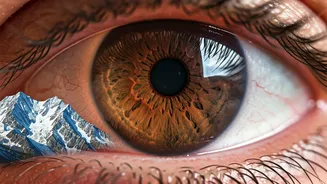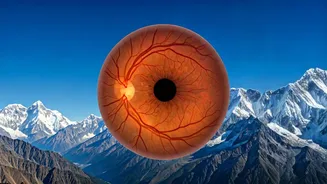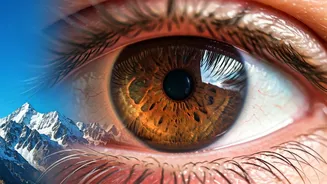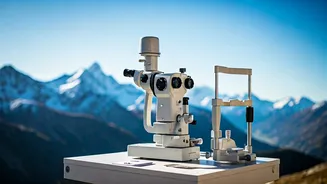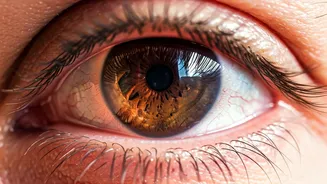Altitude and Eyes
High-altitude retinopathy is a condition that impacts the eyes, specifically affecting the retina, and is triggered by the decrease in oxygen levels present
at high altitudes. The retina, which is a crucial element of the eye for vision, experiences a reduced supply of oxygen. This oxygen deprivation leads to the expansion of blood vessels within the retina. These enlarged vessels can then leak blood and fluid, potentially causing vision impairment. Several factors contribute to this condition, including the altitude itself, the length of time spent at the high altitude, and individual health factors. Symptoms may range from mild, such as blurred vision, to more severe, like significant vision loss. The case presented involves an eye surgeon who experienced vision loss while hiking at an altitude of 15,000 feet, highlighting the potential risks associated with high-altitude activities.
Symptoms and Diagnosis
The symptoms of high-altitude retinopathy can vary depending on the severity of the condition, though blurred vision is one of the most common early indicators. Other possible symptoms can include the presence of spots or floaters in the field of vision, which arise from the leakage of blood or fluid within the eye. In some cases, individuals might experience a decrease in their overall visual acuity, which means it becomes harder to see clearly. The diagnosis generally starts with a comprehensive eye examination, where an ophthalmologist will evaluate the retina. They will use specialized tools to inspect the blood vessels and detect any signs of leakage or swelling. Fundus photography, which produces detailed images of the retina, is often employed to visualize the damage. In specific cases, doctors might also perform an optical coherence tomography (OCT) scan to create cross-sectional images of the retina, identifying swelling or fluid build-up.
Treatment Approaches
Treatment for high-altitude retinopathy is primarily focused on mitigating the impact of the condition and safeguarding the patient's vision. The primary measure involves descending to a lower altitude, as the reduced oxygen levels are the main cause of the issue. The descent helps to improve oxygen supply to the retina and encourage the blood vessels to return to their standard size, thus reducing the leakage. If the symptoms are severe, the ophthalmologist may recommend specific treatments. These might include the use of medications to minimize inflammation and control the leakage. In some cases, laser therapy might be used to seal the leaking blood vessels and reduce the fluid build-up in the retina. Regular monitoring is essential to ensure that the condition improves, and the vision is maintained. Prevention methods include gradually ascending to high altitudes, giving the body time to adjust, and staying hydrated.
Real-Life Case Insights
An eye surgeon shared a personal experience of vision loss that occurred while hiking at an altitude of 15,000 feet. The surgeon's experience serves as an important illustration of the potential dangers associated with activities at high altitude. The incident underscores the rapid onset of the condition, which can catch even healthcare professionals by surprise. This surgeon's case emphasizes the need for rapid intervention and the importance of recognizing the symptoms early. Additionally, it highlights how quickly the visual health can deteriorate in a high-altitude setting. The surgeon's account reinforces the significance of taking preventive measures and seeking prompt medical attention when experiencing any visual problems at high altitudes. It helps highlight the importance of understanding the potential impact of high-altitude activities on vision and acting quickly in case of symptoms.
Prevention and Safety
Preventing high-altitude retinopathy includes several key measures. The primary one is to gradually increase your altitude, allowing your body to adapt slowly to the lower oxygen levels. Avoid sudden ascents. Proper acclimatization is extremely important. If you're planning a trip to high altitudes, consult your doctor. They can give you advice tailored to your medical history and specific health conditions. Staying hydrated is also very important, as dehydration can aggravate the symptoms. Wear sunglasses that offer adequate protection from the sun's ultraviolet (UV) radiation, as they can cause eye damage at high altitudes. Be alert for any changes in your vision, such as blurriness, floaters, or decreased visual acuity. If any of these problems occur, quickly descend to a lower altitude and seek medical attention from a qualified ophthalmologist. Your prompt response can help prevent any more damage.








